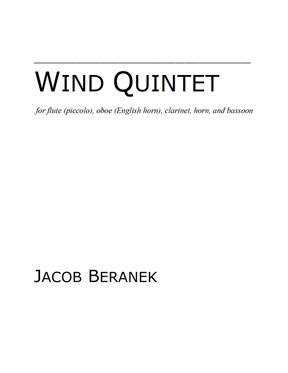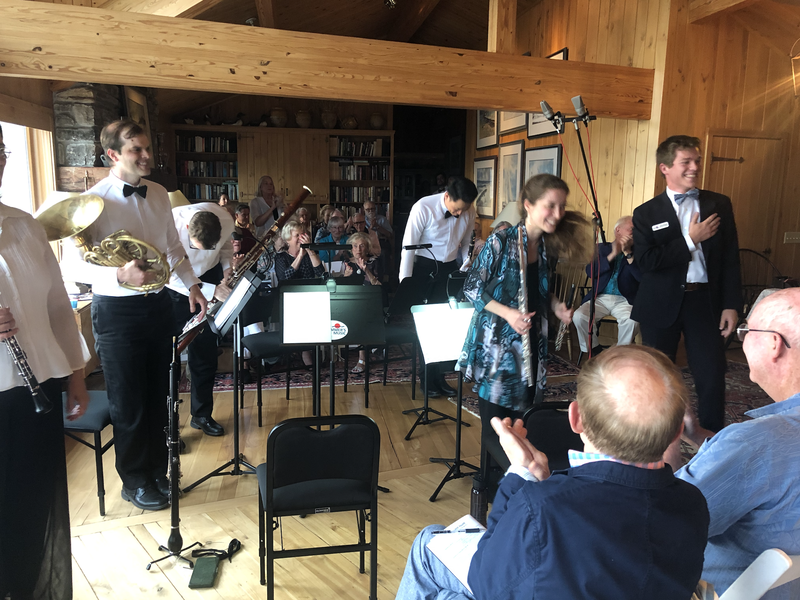WIND QUINTET (2019)
flute (piccolo), oboe (English horn), clarinet, horn, bassoon
flute (piccolo), oboe (English horn), clarinet, horn, bassoon
|
Score & Parts (digital download): $20.00
Score Only (digital download): $15.00 Score & Parts (hard copy): $50.00 + shipping Score Only (hard copy): $25.00 + shipping |
PROGRAM NOTES
The modern wind quintet has enjoyed a rich, colorful history for two centuries. With this Wind Quintet, I strove to put my own personal spin on the genre while still honoring its heritage. The resulting work, therefore, is a study in tradition and play, upholding my philosophy of writing something I’d enjoy if I were sitting in the audience—and something that hopefully fulfills players in rehearsal and performance.
The first movement is in classic sonata-allegro form. This choice was an experiment to see if this tried, embraced, discarded, and re-embraced mold stands the test of time, making it “my own” only by placing my own ideas inside. The second movement takes the form of a rondo with a reflective introduction and lively coda. This mixed-meter movement is built around a repetitive, jaunty A theme that returns twice after its first statement, with contrasting themes sandwiched in between (ABACA). The third movement is a theme and variations—or perhaps more accurately, a hymn and investigations. After the theme (which begins with a brief quotation of Vaughan Williams’s Sine nomine), a jiglike variation in 6/8 leads into a more pensive variation with the theme covered-up in the bassline. A pointillist restatement of the theme pops up and dances right into a fugue, which is the largest of the five variations. After hearkening back to my original hymn tune in a chorale-like final variation, the third movement settles to a close, and the finale begins. This last movement is ternary (ABA) and features an A theme built around two syncopated tunes which are contrasted by a flowing B section. The A section returns after some finagling, and once it pulls itself together, rushes headlong to a jubilant conclusion, joyously concluding the celebration.
—Jacob Beranek
The modern wind quintet has enjoyed a rich, colorful history for two centuries. With this Wind Quintet, I strove to put my own personal spin on the genre while still honoring its heritage. The resulting work, therefore, is a study in tradition and play, upholding my philosophy of writing something I’d enjoy if I were sitting in the audience—and something that hopefully fulfills players in rehearsal and performance.
The first movement is in classic sonata-allegro form. This choice was an experiment to see if this tried, embraced, discarded, and re-embraced mold stands the test of time, making it “my own” only by placing my own ideas inside. The second movement takes the form of a rondo with a reflective introduction and lively coda. This mixed-meter movement is built around a repetitive, jaunty A theme that returns twice after its first statement, with contrasting themes sandwiched in between (ABACA). The third movement is a theme and variations—or perhaps more accurately, a hymn and investigations. After the theme (which begins with a brief quotation of Vaughan Williams’s Sine nomine), a jiglike variation in 6/8 leads into a more pensive variation with the theme covered-up in the bassline. A pointillist restatement of the theme pops up and dances right into a fugue, which is the largest of the five variations. After hearkening back to my original hymn tune in a chorale-like final variation, the third movement settles to a close, and the finale begins. This last movement is ternary (ABA) and features an A theme built around two syncopated tunes which are contrasted by a flowing B section. The A section returns after some finagling, and once it pulls itself together, rushes headlong to a jubilant conclusion, joyously concluding the celebration.
—Jacob Beranek





